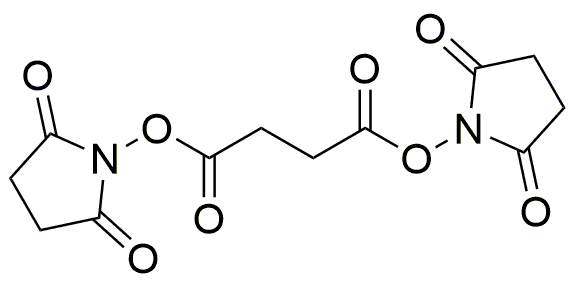Disuccinimidyl succinate is widely utilized in research focused on:
- Protein Cross-Linking: This compound serves as a versatile cross-linker in bioconjugation, allowing researchers to create stable protein complexes for studying protein interactions and functions.
- Vaccine Development: It is employed in the formulation of vaccines, enhancing the stability and efficacy of antigens by facilitating their conjugation to carrier proteins.
- Drug Delivery Systems: The compound is used to modify nanoparticles, improving the targeted delivery of therapeutic agents in cancer treatment and other diseases.
- Diagnostic Assays: In the field of diagnostics, it aids in the development of assays by linking biomolecules, which enhances the sensitivity and specificity of detection methods.
- Biomaterials: Disuccinimidyl succinate is utilized in creating biocompatible materials for tissue engineering, promoting cell adhesion and growth in regenerative medicine applications.
General Information
Properties
Safety and Regulations
Applications
Disuccinimidyl succinate is widely utilized in research focused on:
- Protein Cross-Linking: This compound serves as a versatile cross-linker in bioconjugation, allowing researchers to create stable protein complexes for studying protein interactions and functions.
- Vaccine Development: It is employed in the formulation of vaccines, enhancing the stability and efficacy of antigens by facilitating their conjugation to carrier proteins.
- Drug Delivery Systems: The compound is used to modify nanoparticles, improving the targeted delivery of therapeutic agents in cancer treatment and other diseases.
- Diagnostic Assays: In the field of diagnostics, it aids in the development of assays by linking biomolecules, which enhances the sensitivity and specificity of detection methods.
- Biomaterials: Disuccinimidyl succinate is utilized in creating biocompatible materials for tissue engineering, promoting cell adhesion and growth in regenerative medicine applications.
Documents
Safety Data Sheets (SDS)
The SDS provides comprehensive safety information on handling, storage, and disposal of the product.
Product Specification (PS)
The PS provides a comprehensive breakdown of the product’s properties, including chemical composition, physical state, purity, and storage requirements. It also details acceptable quality ranges and the product's intended applications.
Certificates of Analysis (COA)
Search for Certificates of Analysis (COA) by entering the products Lot Number. Lot and Batch Numbers can be found on a product’s label following the words ‘Lot’ or ‘Batch’.
*Catalog Number
*Lot Number
Certificates Of Origin (COO)
This COO confirms the country where the product was manufactured, and also details the materials and components used in it and whether it is derived from natural, synthetic, or other specific sources. This certificate may be required for customs, trade, and regulatory compliance.
*Catalog Number
*Lot Number
Safety Data Sheets (SDS)
The SDS provides comprehensive safety information on handling, storage, and disposal of the product.
DownloadProduct Specification (PS)
The PS provides a comprehensive breakdown of the product’s properties, including chemical composition, physical state, purity, and storage requirements. It also details acceptable quality ranges and the product's intended applications.
DownloadCertificates of Analysis (COA)
Search for Certificates of Analysis (COA) by entering the products Lot Number. Lot and Batch Numbers can be found on a product’s label following the words ‘Lot’ or ‘Batch’.
*Catalog Number
*Lot Number
Certificates Of Origin (COO)
This COO confirms the country where the product was manufactured, and also details the materials and components used in it and whether it is derived from natural, synthetic, or other specific sources. This certificate may be required for customs, trade, and regulatory compliance.


